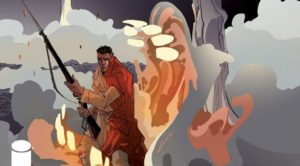“Scarlet Witch #1”
Marvel Comics, December 2, 2015
Writer: James Robinson
“Scarlet Witch #1” is part of Marvel Comic’s All-New, All-Different (ANAD) rebranding campaign. The proposition is that the role and visual identities of established superheroes are taken over by other characters. There is a palpable sense of invigoration attached to the process, and especially with this particular title.
Scarlet Witch is a character created in 1964, and has mostly appeared as a second-tier character in Marvel Comics’ title “The Avengers”. The character is endowed with superpowers consisting of an amorphous ability to trigger improbable events under the vague term, “chaos magic”. This character has been entangled in a myriad of convoluted stories over the years, used often as the plot device for seeding large scale changes in title direction, and usually under the weak guise of some form of temporary insanity or nervous breakdown. This has, frankly, been tiresome and repetitious. A small cult following has perpetuated interest in the character, but on the whole the property never enjoyed the same amount of mainstream success as other characters drawn from “The Avengers” title.
Unlike most of Marvel Comics’ ANAD titles, the main character in “Scarlet Witch” has not been replaced. Instead, the plot of this title is intended to take the character in an entirely new direction.
Scarlet Witch #1 shows that the eponymous witch has what it takes to carry a franchise and drive a story. Mr Robinson, the writer, seems intent on taking the character away from a cadre of spandex-clad superheroes and instead operate alone. One of the first things that “Scarlet Witch #1” addresses is the character’s powers. The character’s powers are just witchcraft and magic now – not “chaos magic” (there is even a slight self-referential dig at the term.) The ability to use magic was not fleshed out much in this first issue, but Mr Robinson’s strategy of simplification is clear. It goes a small way to making the character more accessible to new readers who would otherwise be scratching their heads and wondering what on earth “chaos magic” was. Less sophisticated readers reading the character’s adventures in the past most likely assumed that they were seeing conjured bolts of energy: more astute readers understood it as the mutant ability to affect probabilities. Readers seeking action-fuelled escapism no doubt revel in witnessing an ability to blast things into cinders, but are, perhaps, less impressed by the power to affect the chances that an enemy would trip. It is not really the kind of dramatic visual fireworks that typically sells superhero comic books.
This issue provides a motivation for the character’s decision to go solo. Living in a high-rise building somewhere in New York city, trading barbs with the ghost of a witch (Agatha Harkness, a deceased supporting character from another Marvel Comics’ title, “Fantastic Four”), and sensing a malign use of magic, together generate a very different thematic impression from being a supporting character in the team of capes and masks contained in “The Avengers”. There is a brooding sense of impending horror, suggestive that this title should sit amongst others such as DC Comics’ “Hellblazer” or Marvel Comics’ “The Hulk” when it was penned by Bruce Jones from 2001-2005.
There is some irony to this. DC Comics has a very successful imprint, called Vertigo Comics. Vertigo Comics has suffered from editorial misdirection in recent years, with:
Marvel Comics may be using “Scarlet Witch” to occupy the space left by “Hellblazer”. If that is the case, it is an astute gamble.
The first issue, while self-contained, is a set-up to a larger story arc. The title character notices something amiss with a string of murders in the city, which involve wealthy individuals being murdered by assistants or servants without any motive or even recollection of the events. She approaches the investigator in charge of the case and takes him to one of the crime scenes. The character notices dead cats on the streets, which the investigator dismissed as quite ordinary for New York. But the Scarlet Witch sees a link to the dead cats to an incident before the French revolution, involving a bloody pogrom of cats by servants and commoners. It is more than just a symbolic expression of class discontent, the lower class demonstrating hatred for the unjust pampering that animals get from wealthy owners. The character explains that the French peasantry were under the influence of a witch who had been sacrificing cats in order to summon a demon from hell, triggering revolution. Anyone even slightly paying attention will see the plot’s conclusion from a mile away, but it is not a deal breaker. “Scarlet Witch #1” is a great relaunch for the character and is a great comic book in and of itself.
Perhaps most importantly, like many of the ANAD titles, “Scarlet Witch” touches on social issues such as the disconnect and animosity between the affluent and the poverty-stricken, and the discrimination that women deal with on a daily basis. But unlike most of the ANADs, the issues being are being tackled in a more nuanced, less didactic way. Witchcraft provides spice to the story. Nobody should find any substantive faults in Mr Robinson’s writing in this issue.
It is still early to say and the series could lapse to the humdrum safety of superheroics after a few issues. But if the first issue is anything to go by, “Scarlet Witch” is a recommended read.

